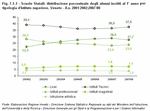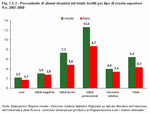7.1 - Choice of secondary school
|
In recent years significant changes have taken place in secondary education in Italy. A school-leaving certificate is no longer sufficient to find a good job. Once many professions, such as that of accountant or surveyor, required a 'simple' school-leaving certificate, but now at least a bachelor degree is required. And if it is becoming increasingly necessary to go to university to have a chance on the job market, why not go to the more traditional secondary school? From 2001/2002 to 2007/2008 the number of students enrolled in Italian secondary schools increased by around 149,000 (more than 6%). During this period the lyceums (classical and scientific) had the problem of finding room for 173,000 extra pupils. The technical schools, on the other hand, lost more than 55,000 students. The lyceums grew by 25%, a boom that was unthinkable only a few years before. The technical schools, which saw 6% of their students disappear, suffered most from this swing in numbers Vocational schools also lost students with enrolments down 1% from six years ago. Schools for future teachers, on the other hand, have taken on a new appeal, +19%, since their courses increased to five years of study.
This situation can also be seen in Veneto, with lyceums becoming increasingly crowded to the detriment of technical and vocational schools. Over the last six years, whilst there has been an increase of 20,000 students attending the state schools in Veneto, enrolments in technical and vocational schools have only risen by 2.4% and 0.9% respectively. The lyceums, on the other hand, have almost 13,800 extra students, that is 35% more than in 2001/2002. Schools for teachers are becoming increasingly popular with their new five-year syllabus. Numbers are up by almost 4,000, a rise of 41% on the figures for six years ago. A look at the national numbers for students enrolled in the first year of state secondary schools confirms that students have left the technical and vocational schools for a lyceum education. The number of students signing up for classical and scientific lyceums has risen (+27.5% on 2001/2002), whilst the so-called "professional schools" have lost numbers (-5.7% for technical schools and -7% for vocational schools). The increase in the number of students choosing lyceums is also high in Veneto: between 2001/2002 and 2007/2008 enrolments increased by 37.5%. It should be noted, however, that there are signs of the trend coming to a halt both at a national and regional level. This should come as something of a relief to technical and vocational schools. In fact an analysis of the students enrolled in the first year of secondary school shows a progressive increase in the numbers who chose a lyceum over a technical or vocational education up until 2006/2007, whilst last year the trend was slightly inverted. In more detail, in Veneto, as in Italy, over the years, although technical schools are still more popular, the number of Veneto students who chose to go to a lyceum rose from 22.3% in 2001/2002 (26.2% in Italy) to 28.9% in 2006/2007 (32.3% in Italy). The number enrolling at a technical school, however, went down from 39.1% (37.2% in Italy) to 36.5% (33.4% in Italy). Last year, however, there was a slight drop in numbers choosing a lyceum education and a recovery for the technical schools. In fact in Veneto enrolments for the classical and scientific lyceums fell by more than 1% (in Italy -0.3), whilst there was a 1% increase in numbers enrolling at technical schools (in Italy +0.2%). It is also interesting that back in 2003/2004 numbers enrolling in vocational schools overtook those for the lyceums. (Figure 7.1.1) On the other hand, international students lean towards a vocational education. In the 2007/2008 school year in Italy almost 119,000 students without Italian citizenship enrolled in the upper secondary school, around 16% more than the previous year and making up 4.3% of the total number of students. A total of 40.7% of them chose a vocational school, 37.7% a technical school and only 18.8% enrolled in a lyceum. Foreign students born in Italy, or the so-called "second-generation foreigners", show a different trend. They tend to choose, above all, a lyceum or an art school. In Veneto there are almost 12,600 foreign students in upper secondary schools, 6.4% of the total school population. They tend to choose schools that train students for a well-defined profession. In fact foreign students make up 12.6% of the total number of students in vocational schools (8.7% in Italy); 7.3% in technical schools (4.8% in Italy) and only 2.2% in the lyceums (1.7% in Italy). (Figure 7.1.2) Over recent years, the school system has been affected by many inevitable changes as a response to an increasingly complex society, a need for functional training and education that prepares students for the job market, new models of communication and organisation and a need to promote more active support for our social systems. The following paragraphs analyse highly qualified human capital from various points of view, summarising the students' choices, both of those who come to study in Veneto universities and of Veneto students whether they study in their region or elsewhere. Also analysed are the changes that have come into effect over the years, the international students in our universities, regional mobility for work and study, and intellectual emigration abroad. |
|
Data processed by the Statistics Office of Regione Veneto are collective property; reproduction of this material is authorised for non-commercial purposes only, provided the source "Regione Veneto - Regional Statistics System Management" is acknowledged.
English translation by the University of Padova Language Centre.





